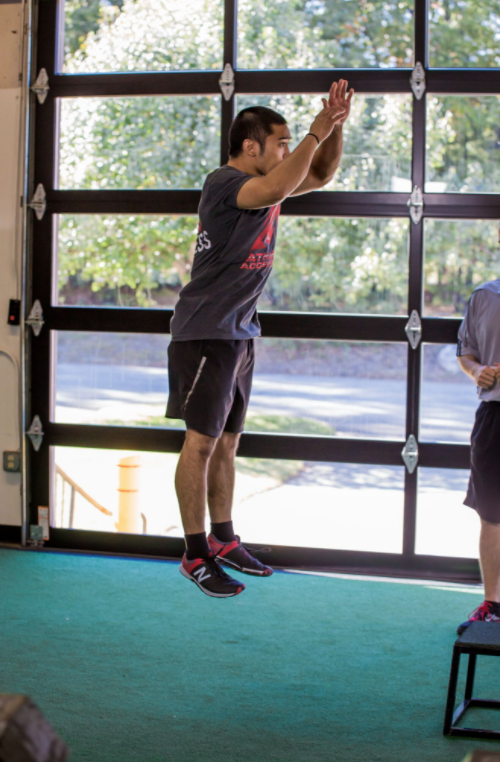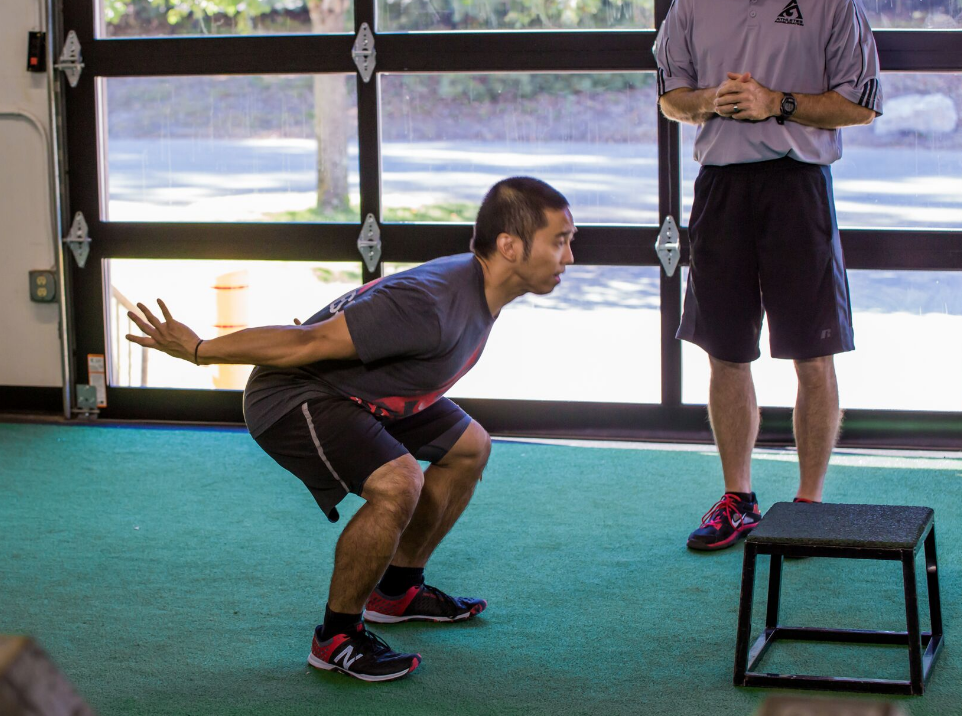Plyometric Training
By: Boo Schexnayder, LSU

I. Plyometric Training
A. Muscular Prestretches
- Prestretch Defined
- Effects of Prestretch
- Examples of Prestretch
B. The Stretch Reflex
C. Elastic Energy
- The Stretch Reflex
- Metabolic Cost
II. Types of Muscle Contractions
A. Concentric
B. Eccentric
C. Isometric
III. The Elastic Response
A. Sequence of the Response
B. Quality of the Response
C. Sources of the Elastic Response
- Contractile Proteins
- Noncontractile proteins
- Proprioceptively Signaled Contraction
- Connective Tissue
D. Coupling Times and Magnitude of Prestretch
- Ideal Coupling Times and Prestretch
- Excessive Coupling Times and Prestretch
- Insufficient Coupling Times and Prestretch
IV. Prerequisites for Advanced Plyometrics
A. Strength Levels
B. Posture
- Postural Strength
- Postural Correctness
- Posture as a Guide
C. Technical Correctness
- Prestabilization
- Amortization
- Pushoff
V. Technical Features
A. Prestabilization
B. Foot Contact Patterns
C. Amortization Patterns
D. Concentric Projection
VI. Types of Plyometrics
A. In Place Jumps
B. Short Bounding
C. Extended Bounding
D. Depth Jumps
VII. Periodization of the Plyometric Program
A. Volume and Intensity
B. Sequencing of Plyometrics
C. Variety in Training
D. Individualization of Training
E. Sample Constructs

Plyometric Training is defined as training that improves the body’s ability to create force using the stretch reflex of muscle tissue. Normally these are jumping exercises, but many other types of training such as sprinting and throwing routines have a large plyometric effect.
Prestretch refers to a stretch8nig of a muscle immediately prior to that muscles contraction. Muscles best work like rubber bands, in that they contract with more force when prestretched. This prestretch enables the muscle to contract with more force than it would ordinarily be able to produce.
Examples of prestretch would be the springlike compression of the takeoff leg prior to jumping, stretching the leg’s extensor muscles. Sweeping the free arm in order to stretch the chest musculature immediately prior to throwing would be another example.
The Stretch Reflex is the name we give to the enhanced contraction resulting from this prestretch.
Elastic energy is the added energy or performance benefit we gain from using the stretch reflex. Efficient techniques are efficient because they enable lots of elastic energy production.
Elastic energy production occurs at no metabolic cost, meaning no fatigue is associated with its production. We must simply employ a technique that elicits this reflex.
There are three types of muscle contractions, and they are all associated with the elastic response. They are concentric, eccentric, and isometric contractions.
A concentric contraction involves the muscle shortening due to contraction, effectively performing work.
An eccentric contraction involves the muscle contracting while being forced to lengthen, working to resist the lengthening action.
An isometric contraction involves no movement. The muscle contracts in order to maintain stability in a particular position.
In a good elastic response, we see stabilizing isometric activity prior to impact, then eccentric activity upon impact, followed by concentric work.
The quality of the isometric phase dictates the quality of the succeeding two phases.
This response and elastic energy production comes from four sources. They are:
- The noncontractile proteins stretch and rebound in elastic fashion.
- The contractile proteins stretch and rebound in elastic fashion, (if they were attached in isometric contraction).
- Proprioceptors sense the stretch and reflexively signal motor neuron to contract the muscle
- Connective Tissue stretch and rebound in elastic fashion.
The tendon is a particularly elastic tissue, and some argue that it has its own reflex. Persons with long tendons are potentially great producers of elastic energy.
There is an ideal amount of prestretch associated with any stretch reflex situation. Prestretch should not be excessive (excessively collapsing in nature), nor insufficient (overly rigid).
Coupling time refers to the amount of time spent converting eccentric to concentric work. The coupling time, like the prestretch should be ideal.
Thus prestretch and coupling time should be optimized, not maximized or minimized.
Advanced plyometrics are very demanding, and certain prerequisites should be accomplished before an athlete can do this type of work. Failure to observe these often results in lack of progress and injury. These are:
1. Adequate strength levels must exist so that the body can effectively withstand impact forces.
2. Proper posture should be taught and demonstrated, so that the body can execute properly. Postural strength should be adequate so that the body can adequately maintain proper posture under impact. Also, proper postural alignment should be taught and demonstrated so that the body can safely receive these forces. Postural evaluation is the best way of evaluating the demand plyometric exercises are placing on the body, and poor posture is an indicator to choose a safer exercise or to stop.
3. Technical correctness should be demonstrated and maintained throughout the exercises, as detailed below.
Proper stabilization of the knee, and ankle prior to impact are an important point to teach. This normally includes some stiffening of the quadriceps group, and a dorsiflexed ankle.
Proper foot contact patterns should be taught. This normally includes a heel to toe, rolling action of the foot.
Proper amortization is another key feature. Amortization should not be minimal or excessive, and should be equally shared between all the joints.
High levels of concentric projection should be shown. The projection resulting from the concentric phase should equal or exceed the drop associated with the eccentric phase.
Plyometrics are commonly classified into four groups. They are:
- In Place Jumps (low intensity, high volume jumps performed with no displacement, such as jump rope, tuck jumps, lunge jumps, etc.).
- Short Bounding Exercises (Low to medium intensity jumps with low volumes, minimal contacts, and some displacement, and some specific technical component, such as standing long jumps, standing triple jumps, or a few hurdle hops)
- Extended Bounding Exercises (medium to high intensity bounding and hopping routines performed over extended distances, such as LRLR…, RRLL…, etc.)
- Depth Jumps (high intensity, low volume jumps that produce intensity by beginning with a drop from a higher surface, using gravity to increase loading. Examples are a box-standing long jump combination, or a box rebound to another box)
Over time, the plyometric program should involve decreasing volumes. Intensities should increase throughout the developmental period. Some feel that a decrease in intensity should occur during the competitive season.
Because of this, we normally progress over time from In Place Jumps and Short Bounds to Extended Bounds, then to Depth Jumps. Peaking an athlete would involve reversing this order.
Because of the high stress associated with plyometrics, variety in training should be employed to foster adaptation and prevent injury. Various forms of horizontal, vertical, and circuit type activities should be used.
Plyometrics should be individualized so as to provide the proper training stimulus for each athlete. This may mean altering exercise choice or box height in workouts.
Plyometrics are very taxing to the nervous system, so they are normally combined into workouts with other neural type activities. These include sprints, olympic lifts, and other major muscle group lifting exercises.
Typical programs involve two to three days per week of some type of plyometric activity.
Recommended Athletes' Acceleration Products
—————————————————————————–




0 Comments for “Plyometric Training”